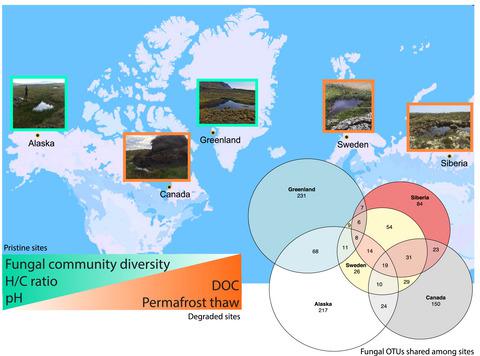当前位置:
X-MOL 学术
›
Glob. Change Biol.
›
论文详情
Our official English website, www.x-mol.net, welcomes your feedback! (Note: you will need to create a separate account there.)
Declining fungal diversity in Arctic freshwaters along a permafrost thaw gradient
Global Change Biology ( IF 11.6 ) Pub Date : 2021-08-30 , DOI: 10.1111/gcb.15852 Mariana Kluge 1 , Maxime Wauthy 2, 3 , Karina Engelbrecht Clemmensen 1 , Christian Wurzbacher 4 , Jeffrey A Hawkes 5 , Karolina Einarsdottir 6 , Milla Rautio 2, 3, 7 , Jan Stenlid 1 , Sari Peura 1
Global Change Biology ( IF 11.6 ) Pub Date : 2021-08-30 , DOI: 10.1111/gcb.15852 Mariana Kluge 1 , Maxime Wauthy 2, 3 , Karina Engelbrecht Clemmensen 1 , Christian Wurzbacher 4 , Jeffrey A Hawkes 5 , Karolina Einarsdottir 6 , Milla Rautio 2, 3, 7 , Jan Stenlid 1 , Sari Peura 1
Affiliation

|
Climate change–driven permafrost thaw has a strong influence on pan-Arctic regions, via, for example, the formation of thermokarst ponds. These ponds are hotspots of microbial carbon cycling and greenhouse gas production, and efforts have been put on disentangling the role of bacteria and archaea in recycling the increasing amounts of carbon arriving to the ponds from degrading watersheds. However, despite the well-established role of fungi in carbon cycling in the terrestrial environments, the interactions between permafrost thaw and fungal communities in Arctic freshwaters have remained unknown. We integrated data from 60 ponds in Arctic hydro-ecosystems, representing a gradient of permafrost integrity and spanning over five regions, namely Alaska, Greenland, Canada, Sweden, and Western Siberia. The results revealed that differences in pH and organic matter quality and availability were linked to distinct fungal community compositions and that a large fraction of the community represented unknown fungal phyla. Results display a 16%–19% decrease in fungal diversity, assessed by beta diversity, across ponds in landscapes with more degraded permafrost. At the same time, sites with similar carbon quality shared more species, aligning a shift in species composition with the quality and availability of terrestrial dissolved organic matter. We demonstrate that the degradation of permafrost has a strong negative impact on aquatic fungal diversity, likely via interactions with the carbon pool released from ancient deposits. This is expected to have implications for carbon cycling and climate feedback loops in the rapidly warming Arctic.
中文翻译:

沿永久冻土融化梯度的北极淡水中真菌多样性下降
气候变化驱动的永久冻土融化对泛北极地区有很大影响,例如通过形成热岩溶池。这些池塘是微生物碳循环和温室气体产生的热点,人们一直在努力解开细菌和古细菌在循环利用从退化流域到达池塘的越来越多的碳方面的作用。然而,尽管真菌在陆地环境中的碳循环中发挥了公认的作用,但永久冻土融化与北极淡水中真菌群落之间的相互作用仍然未知。我们整合了来自北极水生态系统 60 个池塘的数据,这些池塘代表了永久冻土完整性的梯度,跨越了五个地区,即阿拉斯加、格陵兰、加拿大、瑞典和西西伯利亚。结果表明,pH 值和有机质质量和可用性的差异与不同的真菌群落组成有关,并且大部分群落代表未知的真菌门。结果显示,永久冻土退化程度更高的景观池塘中,真菌多样性降低了 16%–19%,根据β多样性进行评估。同时,具有相似碳质量的地点共享更多物种,使物种组成的变化与陆地溶解有机物的质量和可用性保持一致。我们证明,永久冻土的退化对水生真菌多样性有很强的负面影响,可能是通过与古代沉积物释放的碳库的相互作用。预计这将对迅速变暖的北极地区的碳循环和气候反馈循环产生影响。
更新日期:2021-10-15
中文翻译:

沿永久冻土融化梯度的北极淡水中真菌多样性下降
气候变化驱动的永久冻土融化对泛北极地区有很大影响,例如通过形成热岩溶池。这些池塘是微生物碳循环和温室气体产生的热点,人们一直在努力解开细菌和古细菌在循环利用从退化流域到达池塘的越来越多的碳方面的作用。然而,尽管真菌在陆地环境中的碳循环中发挥了公认的作用,但永久冻土融化与北极淡水中真菌群落之间的相互作用仍然未知。我们整合了来自北极水生态系统 60 个池塘的数据,这些池塘代表了永久冻土完整性的梯度,跨越了五个地区,即阿拉斯加、格陵兰、加拿大、瑞典和西西伯利亚。结果表明,pH 值和有机质质量和可用性的差异与不同的真菌群落组成有关,并且大部分群落代表未知的真菌门。结果显示,永久冻土退化程度更高的景观池塘中,真菌多样性降低了 16%–19%,根据β多样性进行评估。同时,具有相似碳质量的地点共享更多物种,使物种组成的变化与陆地溶解有机物的质量和可用性保持一致。我们证明,永久冻土的退化对水生真菌多样性有很强的负面影响,可能是通过与古代沉积物释放的碳库的相互作用。预计这将对迅速变暖的北极地区的碳循环和气候反馈循环产生影响。

























 京公网安备 11010802027423号
京公网安备 11010802027423号